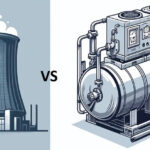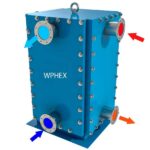What is double pipe heat exchanger? Double pipe heat exchanger is perhaps the simplest of all heat exchanger types.
What is Double pipe heat exchanger
Double pipe heat exchangers are also known as hairpin, jacketed pipe, jacketed U-tube and concentric pipe. These styles of double pipe may have a bundle of inner tubes rather than a single tube and the limits on these styles are the number of tubes (less than 30 tubes) and the diameter of the outer pipe/tube is less than 200 mm. Typically double pipe heat exchangers are designed to provide counter current flow and they are used for low heat duties with surface area requirements less than 47 m2. When larger heat exchange duty is required a number of these units can be connected in series or parallel to fit into the space available.
The simplest form of double heat exchanger (see images below) is a single pipe placed concentrically inside a larger pipe. The inner pipe can be plain or have longitudinal fins attached to increase the surface available for heat transfer. Fins can be attached to the pipe by welding, soldering, by mechanical insertion into grooves or can be integral with the piping.



The most widely used double pipe heat exchanger is the hair pin. The high stresses produced by differential thermal expansion between outer and inner pipes are more easily handled. Manifolding of a multiple hair-pin setup is easily accommodated. When using multiple hair-pin double pipe heat exchangers all the exchangers do not have the same dimension.
Advantages and Disadvantages
| Advantages | Disadvantages |
| Suited to high pressure applications. | Limited to low heat duties requiring surface areas less than 47 m2 |
| Standardization, simplifies maintenance, servicing and stocking of parts. | Flow pattern is strictly counterflow; there is no cross flow. |
| Flexibility, units can be added or removed as required. | As units are added on the possibility of leakage increases because of the number of connections increases. |
| Modular type construction. |
Useful Books
1. D. Q. Kern, Process Heat Transfer, McGraw-Hill, International Edition, 1950
2. G. F. Hewitt, G. L. Shires, T. R. Bott, Process Heat Transfer, CRC Press, 1994
3. Standards of Tubular Exchanger Manufacturers Association, 2nd Edition, NewYork, 1949
Useful Software
Double Pipe Heat Exchanger Design (DHex) By Khaled Aljundi – Webbusterz Engineering Software










